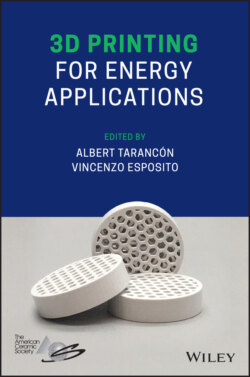Читать книгу 3D Printing for Energy Applications - Группа авторов - Страница 34
1.5.5 Functionally Graded Components in Sintered Components
ОглавлениеGiven the limitations for powder‐bed and vat photopolymer systems, functionally graded components that are built from multiple materials are difficult to manufacture by hybrid AM/sintering as feedstock will be cross‐contaminated in‐situ. As a result, hereof, functional gradients in hybrid AM/sintered components are primarily obtained through geometry. By application of flexure mechanisms, from topology optimization and from graded unit cells in cellular structured metamaterials, it is though possible to derive novel functionality. Select examples are such as negative Poisson's ratio [98], negative thermal expansion [99], acoustic properties [100], and bioinspired structures [101] and bioinspired hierarchical microstructures [102]. The high fidelity of small features that can be manufactured using a hybrid AM/sintering approach, as described in Section 1.5.1, renders these technologies particularly interesting for such topology optimized metamaterials. Extrusion‐based hybrid AM/Sintering offers a novel opportunity to sinter multi‐material components as a result of the inherent capabilities of this process. This opens a possibility to combine widely different particle loaded filaments to fabricate green bodies that form, for example, metallic/ceramic composites that can be subsequently sintered [103]. This method does set demands for the dissimilar materials to have an overlap in sintering temperature interval and thermal expansion coefficients.
